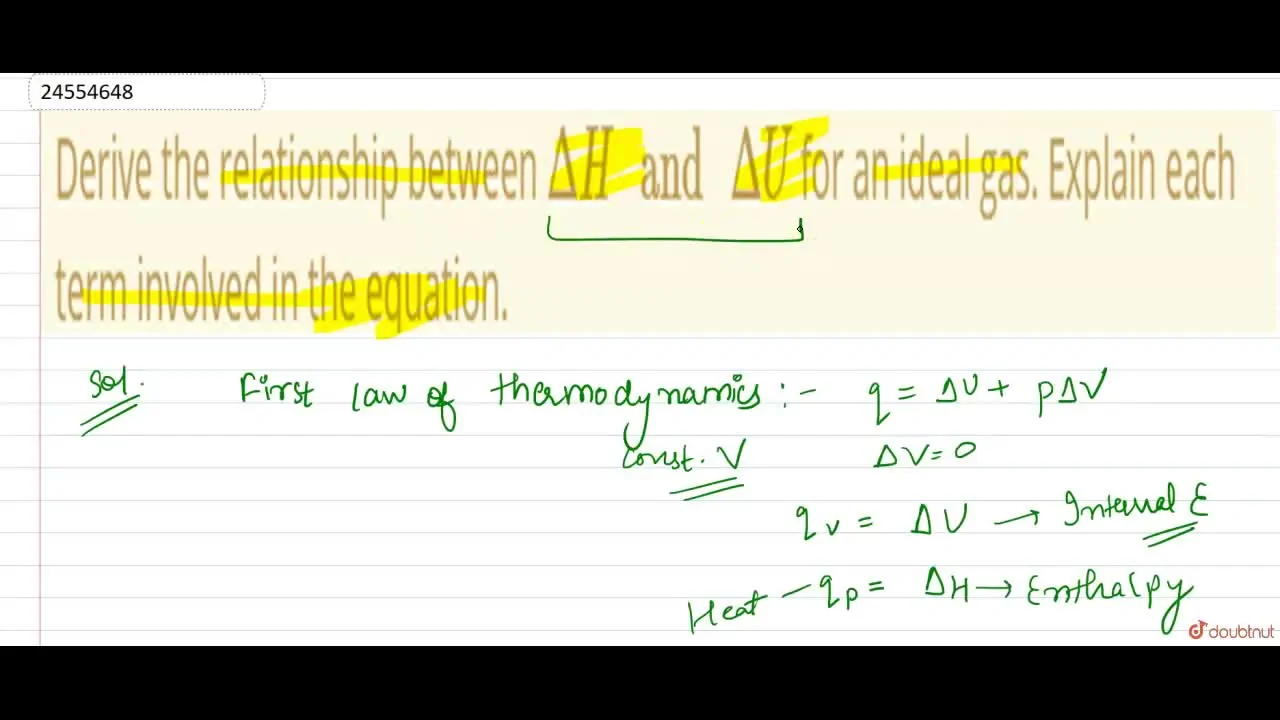Derive the relationship between ΔH and ΔU for an ideal gas. Explain each term involved in the equation.
Video Solution
Text Solution
From the first law of thermodyanmics, q=ΔU+pΔV
If the process carried out at constant volume, ΔV=0
Hence, qv=ΔU
[Here, qv= Heat absorbed at constant volume, ΔU= change in internal energy]
Similarly, qp=ΔH
Here, qp= heat absorbed at constant pressure
ΔH= enthalpy change of the system
Enthalpy change of a system is equal to the heat absorbed or evolved by the system at constant pressure.
As we know that at constant pressure, ΔH=ΔU+pΔV
Where, ΔV is the change in volume.
This equation can be rewritten as ΔH=ΔU+p(Vf−Vi)=ΔU+(pVf−pVi)....(i)
where, Vi= initial volume of the system Vf= final volume of the system
But for the ideal gases, pV=nRT
So that pV1=n1RT
and pV2=n2RT
where, n1= number of moles of the gaseous reactants
n2= number of moles of the gaseous products.
Substituting these value in Eq. (i) we get
ΔH=ΔU+(n2RT−n1RT)
ΔH=ΔU+(n2−n1)RT
or ΔH=ΔU+ΔngRT
where, Δng=n2−n1 is the difference between the number of moles of the gaseous products and gaseous reactants.
Putting the value of ΔH and ΔU we get
qp=qv+ΔngRT
Note conditions under which qp=qv or ΔH=ΔU
(i) where reactions is carried out in a closed vessel so that volume remains constant i.e., ΔV=0
(ii) when reaction involves only solids or liquids or solutions but no gaseous reactant or product. This is because the volume change of the solids and liquids during a chemcial reaction are negligible.
(iii) When reaction involves gaseous reactant and products but their number of moles are equal (i.e., np=nr) e.g.
H2(g)+Cl2(g)→2HCl(g)
C(s)+O2(g)→CO2(g)
Since, qp is different from qv only in those reactions which involves gaseous reactants and products and (np) gaseous ≠(nr) gaseous.
|
Updated on:21/07/2023
Related Playlists
Similar Questions
Derive the relationship between ΔH and ΔU for an ideal gas. Explain each term involved in the equation.
View SolutionΔHandΔU are related as
View SolutionThe difference between ΔHandΔU is equal to
View SolutionCalculate w,q,ΔH and ΔU for an ideal gas expanding in vaccum
isothermallyView SolutionEnthalpy and Relation Between delta H & delta U
View SolutionThe correct relationship between ΔtandΔ0 is expressed as
View SolutionFor which reaction ΔH=ΔU ?
View SolutionWrite the relation between ΔHandΔU for H2(g)+I2(g)→2HI(g)
View SolutionCalculate w,q,ΔH and ΔU for an ideal gas expanding in vaccum
adiabaticallyView SolutionRelationship between Kf , m and ΔTf can be written as ____.
View Solution


